Mastering the Art of Keeping Your Mums (Chrysanthemum) Blooming Through Fall
As summer’s vibrant blooms begin to wane, the rich tapestry of autumn awaits—led by the magnificent chrysanthemum. But what if your mums could shine brighter and last longer, turning your garden into a fall paradise that defies the first frost? Unearth the secrets seasoned gardeners use to keep these autumn jewels blooming profusely throughout the season.
Chrysanthemums, commonly known as mums, are the quintessential flowers of autumn. Their blooms range from fiery reds and oranges to soft pinks and whites, capturing the essence of the season’s palette. Originating from Asia, mums have been cultivated for over 2,500 years and hold significant cultural importance in countries like China and Japan. They symbolize longevity, rejuvenation, and nobility. In gardens across the world, they signal the transition from the heat of summer to the crisp embrace of fall.
Their versatility is unmatched. Whether used in borders, containers, or as cut flowers, mums add texture and color when many other plants have ceased blooming. Their ability to withstand cooler temperatures makes them indispensable for gardeners looking to extend the beauty of their landscapes.

Why Extended Blooming Matters
An extended blooming period doesn’t just enhance the visual appeal of your garden; it plays a crucial role in supporting local ecosystems. Late-season blooms provide essential nectar and pollen for pollinators like bees and butterflies preparing for winter. By keeping your mums blooming longer, you’re contributing to the health of these vital insects.
Moreover, a garden that remains vibrant deep into the fall can uplift spirits and offer a serene escape. As days grow shorter, the continued presence of colorful flowers can make a significant difference in one’s appreciation of the changing seasons.
Understanding Chrysanthemum Varieties
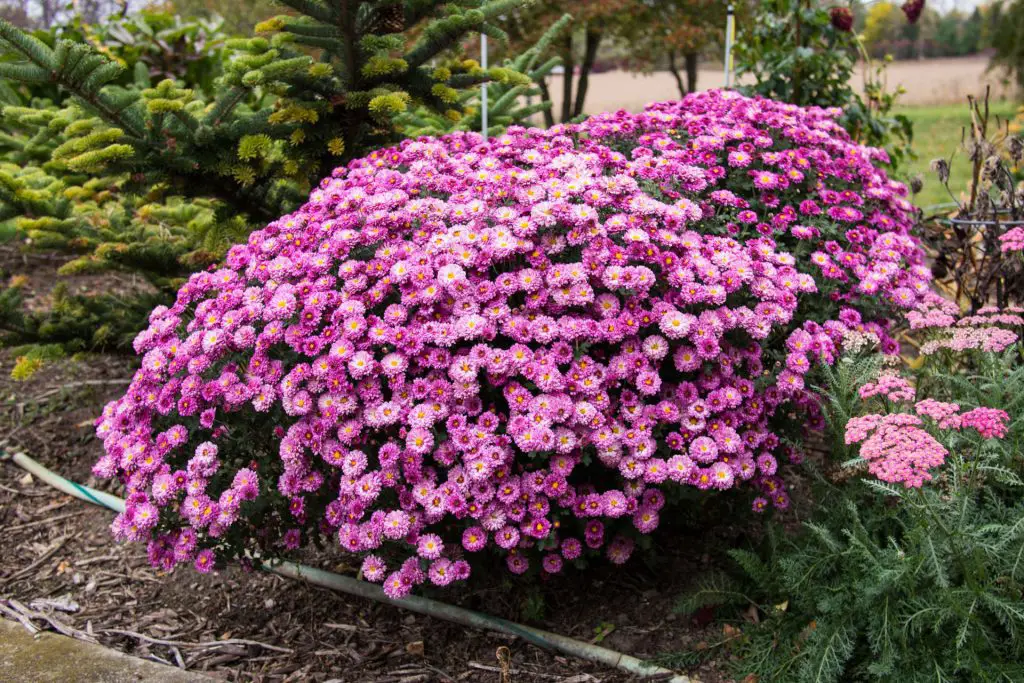
Hardy vs. Florist Mums
Before diving into cultivation techniques, it’s essential to understand the two primary types of chrysanthemums: hardy mums and florist mums.
- Hardy Mums: Also known as garden mums, these are perennials bred to withstand colder climates. They have robust root systems that, when properly cared for, survive winter conditions and return year after year. Hardy mums are ideal for outdoor planting and landscape use.
- Florist Mums: Often seen in bouquets and indoor arrangements, florist mums are bred for their large, showy blooms. While stunning, they lack the hardiness needed to survive outdoors in colder regions. They are typically treated as annuals or houseplants.
Recognizing the difference is crucial for gardeners aiming for longevity. Planting hardy mums increases the likelihood of enjoying their beauty across multiple seasons.
Selecting the Right Cultivars
The variety of mums available can be overwhelming, but selecting the right cultivars can significantly impact blooming duration and plant health.
Top Varieties for Extended Blooms
- ‘Sheffield Pink’: Known for its delicate pink petals and late blooming period, often lasting until the first frost.
- ‘Clara Curtis’: A hardy variety with large, daisy-like pink flowers that bloom profusely.
- ‘Bolero’: Offers rich bronze-red blooms that add warmth to autumn gardens.
- ‘Hillside Sheffield’: Similar to ‘Sheffield Pink’ but with a more robust growth habit.
- ‘Mary Stoker’: Features soft yellow flowers that transition to peach, providing a dynamic color display.
Climate Considerations
Always choose mums suited to your USDA hardiness zone. This ensures the plants can handle local temperature fluctuations. Consult local nurseries or extension services for recommendations tailored to your area.
Optimal Planting Strategies
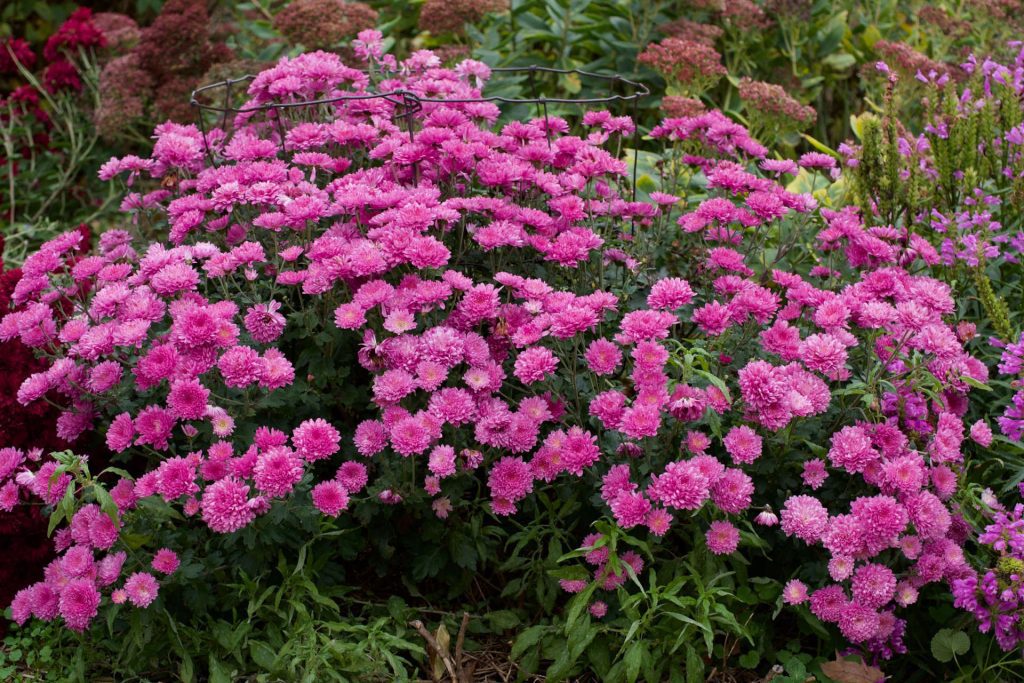
Timing Is Everything
The timing of planting plays a pivotal role in the success of your mums.
Spring Planting
- Benefits: Planting in spring allows mums to establish strong root systems over the growing season. This leads to healthier plants with increased drought resistance and better overwintering success.
- Guidelines:
- Plant after the last expected frost.
- Space plants appropriately to allow for mature growth.
- Incorporate organic matter into the soil to boost fertility.
Late-Season Planting
While planting in late summer or early fall is possible, it presents challenges.
- Risks:
- Insufficient root development before winter.
- Increased susceptibility to frost damage.
- Mitigation Strategies:
- Provide extra mulch around the base for insulation.
- Water consistently to reduce stress.
- Consider planting in containers that can be moved to sheltered locations.
Site Selection
Choosing the right location sets the foundation for healthy, long-blooming mums.
Sunlight Requirements
- Full Sun Exposure: Mums thrive with at least six hours of direct sunlight daily. Adequate light promotes vigorous growth and abundant flowering.
- Avoiding Shade: Planting in shady areas leads to leggy growth and reduced bloom quality.
Soil Preparation
- Drainage: Ensure soil is well-draining to prevent root rot. Raised beds or amended soil can improve drainage in heavy clay soils.
- Soil Fertility:
- Test soil pH; mums prefer slightly acidic to neutral soil (pH 6.5-7.0).
- Incorporate compost or well-rotted manure to boost organic content.
- Avoid overly rich soils that may encourage excessive foliage at the expense of blooms.
Cultivation Techniques for Extended Bloom
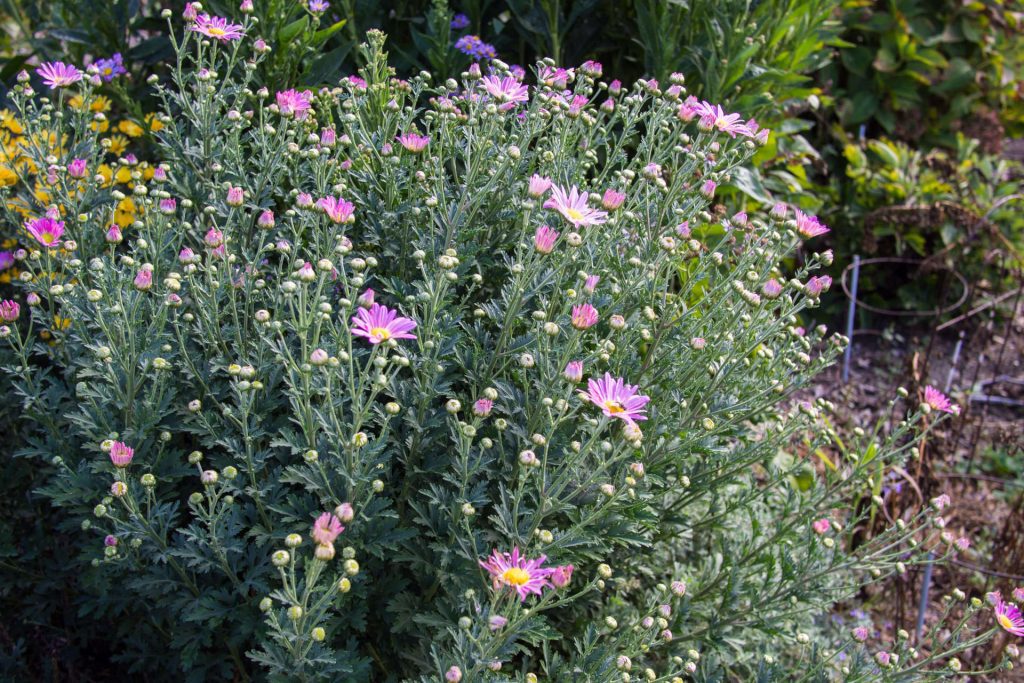
Pinching and Pruning Practices
Proper pinching and pruning are essential for promoting bushier plants with more flowers.
Pinching Technique
- First Pinch:
- When stems reach 6 inches tall, use your fingers or clean shears to remove the top inch of growth.
- This encourages lateral branching.
- Subsequent Pinches:
- Repeat every two to three weeks until mid-July.
- Each pinch should remove 1-2 inches of new growth.
Timing Considerations
- Cease Pinching by Mid-July: Stopping pinching at this time allows flower buds to develop for fall blooming.
- Late Pinching: Pinching later than mid-July can delay flowering or reduce bloom size.
Pruning for Health
- Deadheading: Remove spent flowers to encourage the plant to direct energy toward new blooms.
- Thinning: In overcrowded plants, thin out some stems to improve air circulation, reducing disease risk.
Feeding Your Mums
Providing the right nutrients at the right time boosts bloom quality and plant vigor.
Nutrient Requirements
- Early Season (Nitrogen-Focused):
- Use a balanced fertilizer like 10-10-10.
- Nitrogen promotes leafy growth essential for photosynthesis.
- Mid to Late Season (Phosphorus and Potassium-Focused):
- Switch to a fertilizer higher in phosphorus and potassium, such as 5-10-10.
- Phosphorus supports root development and flowering.
- Potassium enhances overall plant health and disease resistance.
Organic vs. Synthetic Fertilizers
- Organic Options:
- Compost Tea: Provides a gentle nutrient boost and beneficial microorganisms.
- Fish Emulsion: Rich in nitrogen and trace elements.
- Synthetic Options:
- Slow-Release Granules: Offer consistent feeding over time.
- Water-Soluble Fertilizers: Allow precise nutrient control.
Application Tips
- Frequency:
- Fertilize every 4-6 weeks during the growing season.
- Avoid over-fertilization, which can lead to lush foliage but fewer blooms.
- Method:
- Apply fertilizer around the drip line of the plant.
- Water thoroughly after application to prevent root burn.
Watering Your Mums
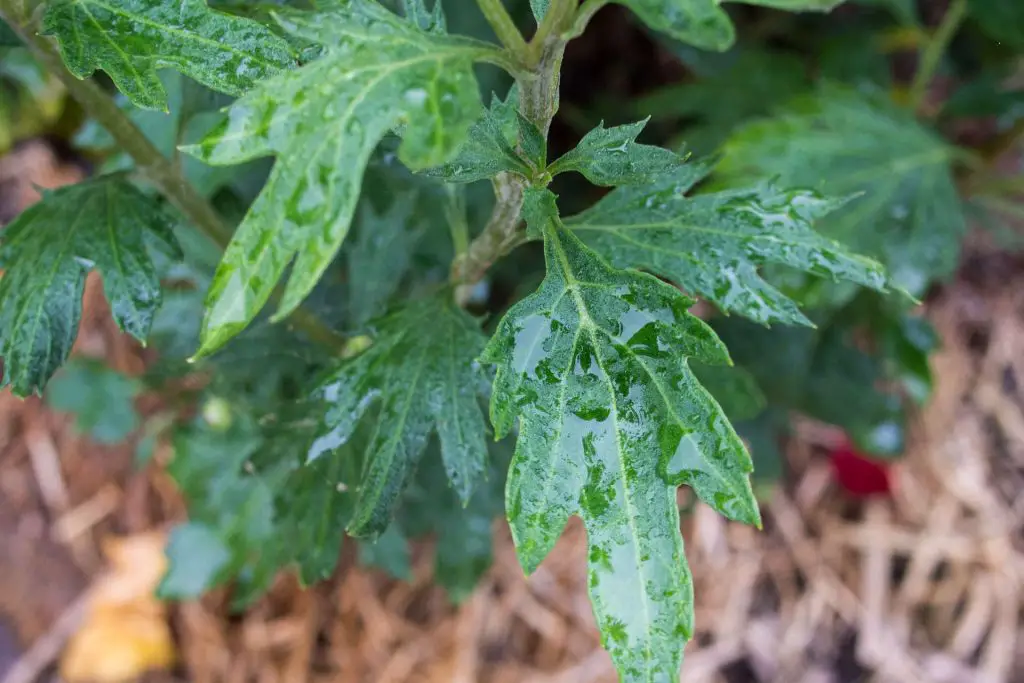
Consistent Moisture Maintenance
Watering practices significantly impact mum health and blooming.
Best Practices
- Deep Watering:
- Water thoroughly to encourage deep root growth.
- Aim for about 1 inch of water per week, adjusting for rainfall.
- Watering at the Base:
- Direct water to the soil, not the foliage.
- Reduces the risk of fungal diseases like powdery mildew.
- Morning Watering:
- Watering in the early morning allows leaves to dry during the day.
- Minimizes moisture on leaves overnight when fungal spores are most active.
Mulching Methods
Applying mulch offers multiple benefits:
- Moisture Retention: Mulch reduces evaporation, keeping soil consistently moist.
- Weed Suppression: Limits competition for nutrients and water.
- Temperature Regulation: Insulates roots from extreme temperature fluctuations.
Mulch Materials
- Organic Mulches:
- Straw: Light and easy to spread.
- Shredded Bark: Long-lasting and decorative.
- Composted Leaves: Free and nutrient-rich.
- Application Tips:
- Apply a 2-3 inch layer around the base, avoiding direct contact with stems.
- Refresh mulch as it breaks down over time.
Light and Temperature Management
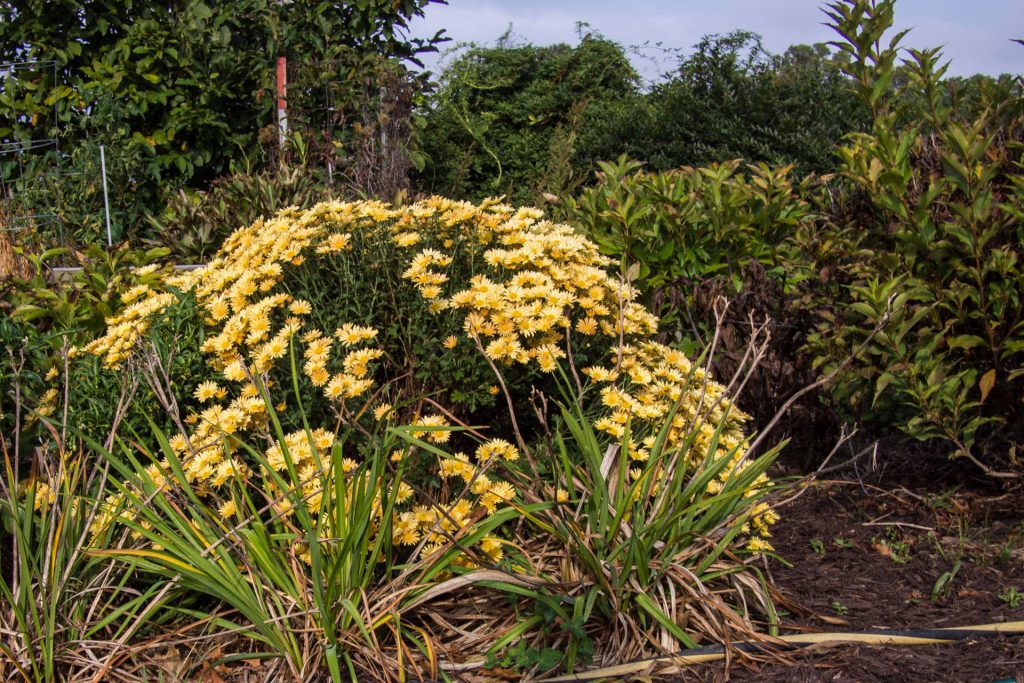
Maximizing Sun Exposure
Understanding mums’ photoperiodic nature helps in managing their bloom time.
Photoperiodism Explained
- Short-Day Plants: Mums initiate flowering as nights become longer in late summer and fall.
- Light Interruption: Exposure to artificial light at night can disrupt this process.
Practical Tips
- Avoid Nighttime Lighting:
- Position mums away from streetlights or outdoor lighting.
- Use curtains or shields if necessary.
- Plant Placement:
- Ensure they receive full sun during the day for energy production.
Protecting from Early Frosts
Early frosts can damage buds and flowers, cutting the blooming season short.
Frost Protection Strategies
- Frost Covers:
- Use breathable fabrics like burlap or commercial frost cloths.
- Cover plants in the evening and remove in the morning.
- Microclimates:
- Plant near south-facing walls or stone features that retain heat.
- These areas stay warmer overnight, offering natural protection.
- Watering Before Frost:
- Moist soil retains heat better than dry soil.
- Watering the day before a predicted frost can help protect roots.
Long-Term Solutions
- Windbreaks:
- Plant hedges or install fences to reduce cold winds.
- Raised Beds:
- Soil in raised beds warms up faster in spring and stays warmer in fall.
Pest and Disease Prevention
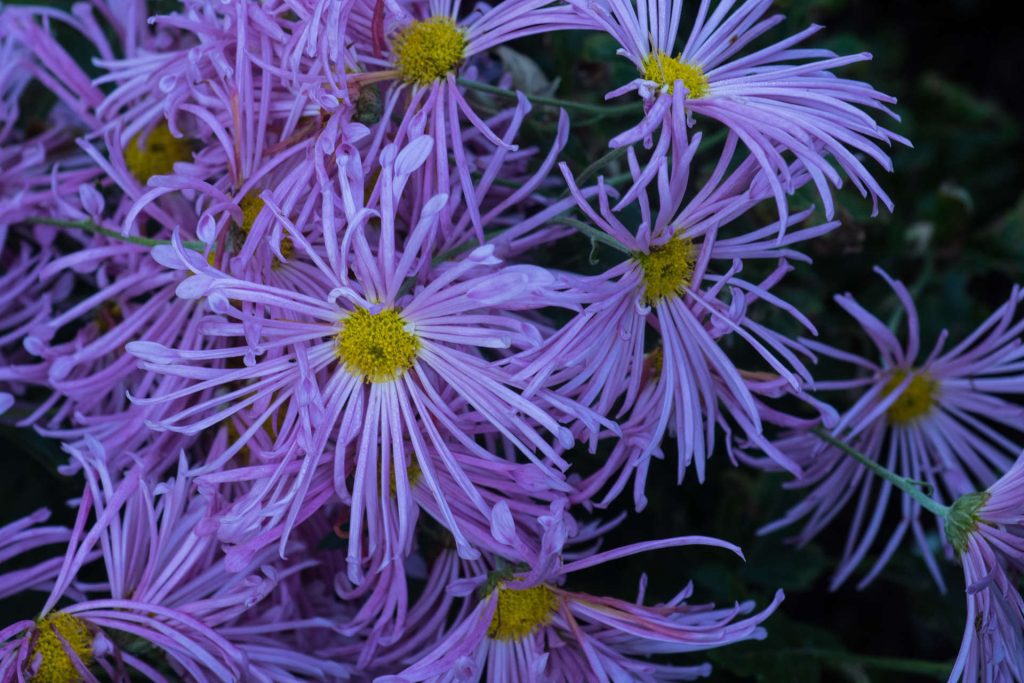
Common Threats to Mums
Identifying and managing pests early prevents significant damage.
Insect Pests
- Aphids:
- Small, soft-bodied insects that suck sap from leaves and stems.
- Control:
- Spray with insecticidal soap.
- Introduce beneficial insects like ladybugs.
- Leaf Miners:
- Larvae that tunnel within leaves, creating visible trails.
- Control:
- Remove and destroy affected leaves.
- Use neem oil to deter adults.
- Spider Mites:
- Tiny pests causing stippled leaf damage and fine webbing.
- Control:
- Increase humidity around plants.
- Apply miticides if infestation is severe.
Disease Management
Preventing diseases is easier than curing them. Good cultural practices are the first line of defense.
Fungal Diseases
- Powdery Mildew:
- White, powdery growth on leaves.
- Prevention:
- Ensure proper spacing for airflow.
- Avoid overhead watering.
- Botrytis Blight:
- Gray mold affecting flowers and stems.
- Prevention:
- Remove dead or damaged plant material.
- Apply fungicides if necessary.
Bacterial Diseases
- Bacterial Leaf Spot:
- Causes dark, water-soaked spots on foliage.
- Control:
- Remove infected leaves.
- Sterilize pruning tools between uses.
Natural Remedies vs. Chemical Treatments
Natural Remedies
- Companion Planting:
- Plant garlic or marigolds nearby to deter pests.
- Homemade Sprays:
- Mix 1 teaspoon of mild liquid soap with 1 liter of water for a gentle insecticide.
Chemical Treatments
- Insecticides and Fungicides:
- Use as a last resort.
- Follow label instructions carefully to protect beneficial insects and the environment.
Companion Planting and Design Ideas
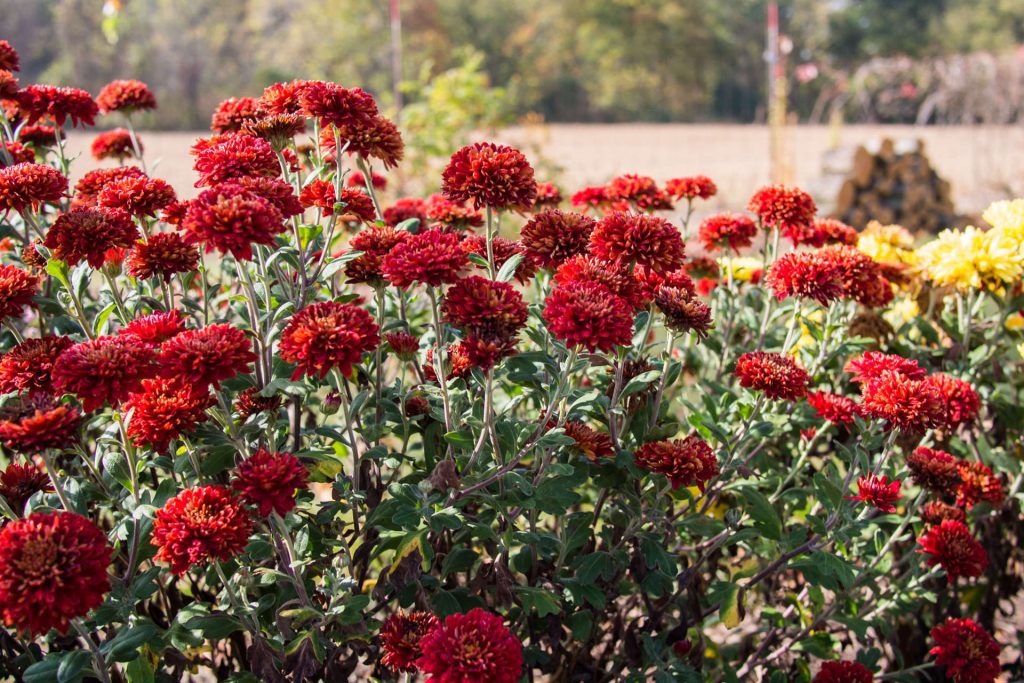
Enhancing Visual Appeal
Strategic plant combinations can create a stunning autumn display.
Companion Plants
- Asters:
- Complement mums with their purple and blue hues.
- Ornamental Grasses:
- Add texture and movement.
- Sedum ‘Autumn Joy’:
- Offers pink flowers that deepen to bronze, harmonizing with mums.
Color Schemes
- Monochromatic:
- Use different shades of one color for a cohesive look.
- Complementary:
- Pair colors opposite each other on the color wheel (e.g., yellow mums with purple asters).
Designing Garden Layouts
Borders and Beds
- Front of Borders:
- Place shorter mum varieties at the front.
- Mixed Beds:
- Intermix mums with perennials and shrubs for depth.
Focal Points
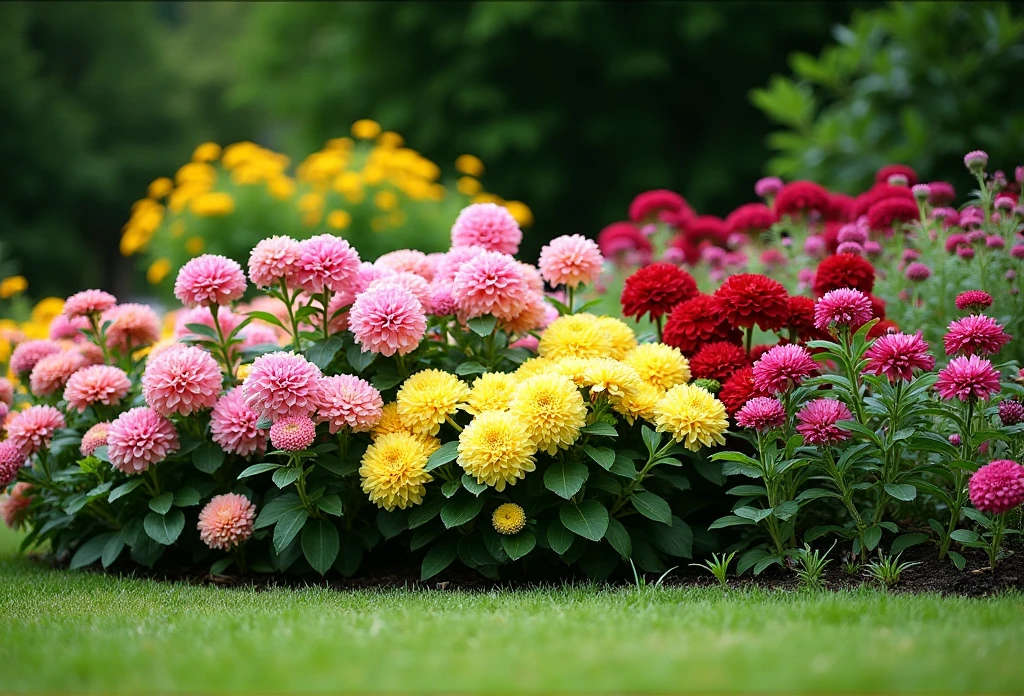
- Specimen Planting:
- Use large mums as eye-catching centerpieces.
- Groupings:
- Plant in clusters of odd numbers for a natural look.
Container Gardening with Mums
Growing mums in containers offers flexibility and additional design options.
Container Selection
- Size:
- Use pots at least 12 inches in diameter for adequate root space.
- Material:
- Terra cotta pots are breathable but dry out quickly.
- Plastic pots retain moisture better.
Soil Mix
- Well-Draining Mix:
- Combine potting soil with perlite or sand.
- Fertilization:
- Incorporate slow-release fertilizer at planting time.
Care Tips
- Watering:
- Containers dry out faster; check moisture levels daily.
- Mobility:
- Move pots to protected areas during harsh weather.
Overwintering Techniques

Preparing Mums for the Cold
Proper winter preparation ensures mums return healthier the following year.
Post-Bloom Care
- Deadheading:
- Remove spent flowers but leave the stems intact.
- Pruning:
- Cut back stems to 8-10 inches after the first hard frost.
Mulching for Winter
- Insulation:
- Apply a thick layer (4-6 inches) of mulch, such as straw or shredded leaves.
- Timing:
- Mulch after the ground freezes to prevent rodents from nesting.
Dividing and Transplanting
Regular division rejuvenates mums and promotes vigorous growth.
When to Divide
- Early Spring:
- Just as new growth emerges.
- Every 2-3 Years:
- Prevents overcrowding and resource competition.
How to Divide
- Dig Up the Plant:
- Carefully lift the entire clump with a spade.
- Separate the Clump:
- Use a sharp knife or spade to divide into smaller sections, each with roots and shoots.
- Replant Divisions:
- Plant at the same depth as before.
- Space adequately to allow growth.
Post-Division Care
- Water Well:
- Helps settle the soil and reduces transplant shock.
- Monitor Growth:
- New divisions may require more attention until established.
Innovative Practices

Using Growth Regulators
Plant growth regulators can manipulate plant development but require expertise.
Benefits
- Control Bloom Time:
- Delay or advance flowering to suit schedules.
- Compact Growth:
- Reduce stem elongation for sturdier plants.
Considerations
- Product Selection:
- Choose regulators labeled for use on mums.
- Application:
- Follow precise dosing instructions.
- Safety:
- Wear protective equipment and store chemicals securely.
Experimental Lighting
Manipulating light exposure can influence mum flowering.
Supplemental Lighting
- Extending Daylight:
- Use grow lights to lengthen day periods, delaying flowering.
- Scheduling:
- Control light exposure with timers.
Light Deprivation
- Inducing Early Blooms:
- Cover plants to simulate longer nights.
- Techniques:
- Use blackout cloths for consistent results.
Equipment Needs
- Grow Lights:
- Full-spectrum lights mimic natural sunlight.
- Timers and Controllers:
- Automate light cycles for precision.
Engaging with the Chrysanthemum Community

Local Clubs and Societies
Connecting with fellow enthusiasts enhances learning and enjoyment.
Benefits
- Knowledge Sharing:
- Exchange tips and experiences.
- Access to Rare Varieties:
- Participate in plant swaps or sales.
Notable Organizations
- National Chrysanthemum Society (NCS):
- Offers resources, events, and publications.
- Local Garden Clubs:
- Provide community and localized advice.
Events and Exhibitions
Participating in events showcases your efforts and inspires others.
Flower Shows
- Exhibition Opportunities:
- Display your best blooms.
- Competition:
- Gain recognition and receive feedback.
Workshops and Seminars
- Educational Programs:
- Learn from experts on advanced techniques.
- Networking:
- Build relationships with growers and industry professionals.
Final Thoughts
Mastering the art of keeping mums blooming throughout fall transforms your garden into a vibrant sanctuary that defies the season’s chill. By selecting the right varieties, implementing strategic planting and care practices, and engaging with the broader gardening community, you can enjoy a dazzling display of chrysanthemums all season long. The journey requires dedication and attention to detail, but the rewards—a garden bursting with color and life when others have faded—are well worth the effort.
